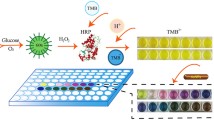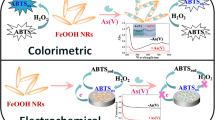Abstract
A colorimetric method is described for the determination of ferrous ion (Fe2+) with high sensitivity and selectivity. The method is based on catalytic etching of gold nanorod (NR). In an acid condition, Fe2+ reacts with H2O2 to produce superoxide radical (O2 •−) that etches gold NRs from the low energy surface along the longitudinal direction preferentially. As a result, the changes in the absorption spectrum and color of gold NR can be measured and also can be detected visually. Under the optimal conditions, the assay has very low detection limit (13.5 nM) and a linear response in a concentration range of 75 to 1 μM. The method was applied to the determination of Fe2+ in spiked samples of fetal bovine serum and also transferred to a kind of test stripe for use in fast practical applications. A unique colorimetric sensing method is demonstrated for the colorimetric detection of Fe2+, again based on the oxidation of gold nanorods which leads to the blue-shift of the absorption.

A unique colorimetric sensing method was shown for the colorimetric detection of Fe2+. Fe2+reacts with H2O2 to generate superoxide radical that oxidize gold nanorods. This leads to a color change from blue-green to pink.






Similar content being viewed by others
References
Li P, Fang L, Zhou H (2011) A new ratiometric fluorescent probe for detection of Fe2+ with high sensitivity and its intracellular imaging applications. Chem Eur J 201117(38):10520–10523
Moin ST, Hofer TS, Pribil AB, Randolf BR, Rode BM (2010) A quantum mechanical charge field molecular dynamics study of Fe2+and Fe3+ ions in aqueous solutions. Inorg Chem 49(11):5101–5106
Sarkar S, Sen S, Chattopadhyay B, Moirangthem A, Basu A, Chattopadhyay P (2012) A ratiometric fluorescent chemosensor for iron: discrimination of Fe2+ and Fe3+ and living cell application. Analyst 137(14):3335–3342
Yavin E, Kikkiri R, Gil S, Arad-Yellin R, Yavin E, Shanzer A (2005) Synthesis and biological evaluation of lipophilic iron chelators as protective agents from oxidative stress. Org Biomol Chem 3(15):2685–2687
Andersen T, Jens E (2005) A novel method for the filter less preconcentration of iron. Analyst 130(3):385–390
Pathak RK, Dessingou J, Hinge VK, Thawari AG, Basu SK, Rao CP (2013) Quinoline driven fluorescence turn on 1,3-Bis-calix[4] arene conjugate-based receptor to discriminate Fe3+ from Fe2+. Anal Chem 85(7):3707–3714
Qu KG, Wang JS, Ren JS, Qu XG (2013) Carbon dots prepared by hydrothermal treatment of dopamine as an effective fluorescent sensing platform for the label-free detection of iron(III) ions and dopamine. Chem Eur J 19(22):7243–7249
Wang M, Wang JG, Xue WJ, Wu AX (2013) A benzimidazole-based ratiometric fluorescent sensor for Cr3+and Fe3+ in aqueous solution. Dyes Pigments 97(3):475–480
Yang CX, Ren HB, Yan XP (2013) Fluorescent metal−organic framework MIL-53(al) for highly selective and sensitive detection of Fe3+ in aqueous solution. Anal Chem 85(15):7441–7446
Wu P, Li Y, Yan XP (2009) CdTe quantum dots (QDs) based kinetic discrimination of Fe2+ and Fe3+, and CdTe QDs-Fenton hybrid system for sensitive Photoluminescent detection of Fe2+. Anal Chem 81(15):6252–6257
Jin Q, Hu YL, Sun YX, Li Y (2015) Room-temperature Phosphorescence by Mn-Doped ZnS Quantum Dots Hybrid with Fenton System for Selective Detection of Fe2+. RSC Adv 5(52):41555–41562
Huang YF, Lin YW, Chang HT (2007) Control of the surface charges of au−ag Nanorods: selective detection of iron in the presence of poly(sodium 4-styrenesulfonate). Langmuir 23(25):12777–12781
Chen L, Li JH, Chen LX (2014) Colorimetric detection of mercury species based on functionalized gold nanoparticles. ACS Appl Mater Interfaces 6(18):15897–15904
Wang JG, Fossey JS, Li M, Li DW, Long YT (2016) Real-time plasmonic monitoring of electrocatalysis on single nanorods. J Electroanal Chem 781(15):257–264
Wang XK, Chen L, Chen LX (2014) Colorimetric determination of copper ions based on the catalytic leaching of silver from the shell of silver-coated gold nanorods. Microchim Acta 181(1–2):105–110
Kubo S, Diaz A, Tang Y, Mayer TS, Khoo IC, Mallouk TE (2007) Tunability of the refractive index of gold nanoparticle dispersions. Nano Lett 7(11):3418–3423
Halas NJ, Lal S, Chang WS, Link S, Nordlander P (2011) Plasmons in strongly coupled metallic nanostructures. Chem Rev 111(6):3913–3961
Link S, El-Sayed MA (2003) Optical properties and ultrafast dynamics of metallic nanocrystals. Rev. Phys Chem 54(54):331–336
Chen ZP, Liu RL, Wang SS, Qu CL, Chen LX, Wang Z (2013) Colorimetric sensing of copper(II) based on catalytic etching of gold nanorods. RSC Adv 3(32):13318–13323
Zhou YL, Dong H, Liu LTXMT (2014) Selective and sensitive colorimetric sensor of mercury (II) based on gold nanoparticles and 4-mercaptophenylboronic acid. Sensor Actuat B-Chem 196(2):106–111
Paresh CR, Sadia AK, Anant KS, Dulal S, Zhen F (2012) Nanomaterials for targeted detection and photothermal killing of bacteria. Chem Soc Rev 43(29):3193–3209
Saa L, Coronado-Puchau M, Pavlov V, Liz-Marzan LM (2014) Enzymatic etching of gold nanorods by horseradish peroxidase and application to blood glucose detection. Nano 6(13):7405–7409
Zhang Z, Chen Z, Qu C, Chen LX (2014) Highly sensitive visual detection of copper ions based on the shape-dependent LSPR spectroscopy of gold Nanorods. Langmuir 30(12):3625–3630
Chen YY, Chang HT, Shiang YC, Hung YL, Chiang CK, Huang CC (2009) Colorimetric assay for lead ions based on the leaching of gold nanoparticles. Anal Chem 81(22):9433–9439
Zhu Q, Wu J, Zhao J, Ni W (2015) Role of bromide in hydrogen peroxide oxidation of CTAB-stabilized gold Nanorods in aqueous solutions. Langmuir 31(14):4072–4077
Li XX, Xiong ZD, Ruan XC, Xia DS, Zeng QF, XuA H (2012) Kinetics and mechanism of organic pollutants degradation with cobalt-bicarbonate-hydrogen peroxide system: investigation of the roleof substrates. Appl Catal A 411(2):24–30
Liu M, ChengX ZL, Lin JM (2006) On-line preparation of Peroxymonocarbonate and its application for the study of energy transfer Chemiluminescence to lanthanide inorganic coordinate complexes. Luminescence 21(3):179–185
Liang SX, Zhao LX, Zhang BT, Lin JM (2008) Experimental studies on the Chemiluminescence reaction mechanism of carbonate/bicarbonate and hydrogen peroxide in the presence of cobalt(II). J Phys Chem A 112(4):618–623
Schaap AP, Thayer AL, Faler GR, Goda K, Kimura T (1974) Singlet molecular oxygen and superoxide dismutase. J Am Chem Soc 91(12):4025–4026
Wood PM (1988) The potential diagram for oxygen at pH 7. Biochem J 253(1):287–289
Lu SM, Chen L, Yang P, Matras-Postolek K (2016) Highly sensitive visual detection of catalase basedon the accelerating decomposition of H2O2 using Au nanorods as a sensor. RSC Adv 6(23):19620–19625
Hu J, Zhuang QF, Wang Y (2016) Label-free fluorescent catalytic biosensor for highly sensitive and selective detection of the ferrous ion in water samples using a layered molybdenum disulfide nanozyme coupled with an advanced chemometric model. Analyst 141(5):1822–1829
Li P, Fang LB, Zhou H, Tang B (2011) A new ratiometric fluorescent probe for detection of Fe(2+) with high sensitivity and its intracellular imaging applications. Chem Eur J 17(38):10520–10523
Sen S, Sarkar S, Chattopadhyay B (2012) A ratiometric fluorescent chemosensor for iron: discrimination of Fe and Fe and living cell application. Analyst 137(14):3335–3342
Kim H, Na YJ, Song EJ, Kyung KKB, Bae JM, Kim C (2014) A single colorimetric sensor for multiple target ions: the simultaneous detection of Fe2+ and Cu2+ in aqueous media. RSC Adv 4(43):22463
Ondigo DA, Tshentu ZR, Torto N (2013) Electrospun nanofiber based colorimetric probe for rapid detection of Fe2+ in water. Anal Chim Acta 804(804C):228–234
Zheng K, Lai CY, He LP, Li F (2010) Chromo-chemodosimetric detection for Fe2+ by Fenton reagent-induced chromophore-decolorizing of halogenated phenolsulfonphthalein derivatives. Chem Sci 53(6):1398–1405
Yang S, Jiang Z, Chen Z, Tong L, Lu J, Wang J (2015) Bovine serum albumin-stabilized gold nanoclusters as a fluorescent probe for determination of ferrous ion in cerebrospinal fluids via the Fenton reaction. Microchim Acta 182(11–12):1911–1916
Hirayama T, Okuda K, Nagasawa H (2013) A highly selective turn on fluorescent probe for iron(II) to visualize labile iron in living cells. Chem Sci 4(3):1250–1256
Praveen L, Reddy MLP, Varma RL (2010) Dansyl-styrylquinoline conjugate as divalent iron sensor. Tetrahedron Lett 51(50):6626–6629
Zhang Z, Chen Z, Pan D, Chen LX (2015) Fenton-like reaction-mediated etching of gold Nanorods for visual detection of Co2+. Langmuir 31(1):643–650
Acknowledgments
This work was supported in part by the projects from the National Natural Science Foundation of China (51572109 and 51501071), Shandong Provincial Natural Science Foundation (ZR2015EL008, China).
Author information
Authors and Affiliations
Corresponding author
Ethics declarations
The author(s) declare that they have no competing interests.
Electronic Supplementary Materials
ESM 1
(DOCX 4.55 MB)
Rights and permissions
About this article
Cite this article
Lu, S., Zhang, X., Chen, L. et al. Colorimetric determination of ferrous ion via morphology transition of gold nanorods. Microchim Acta 185, 76 (2018). https://doi.org/10.1007/s00604-017-2602-8
Received:
Accepted:
Published:
DOI: https://doi.org/10.1007/s00604-017-2602-8




